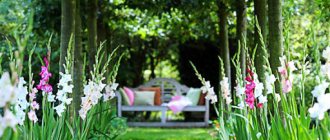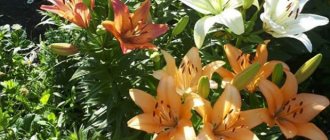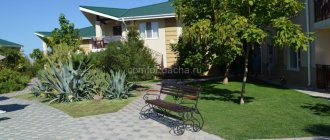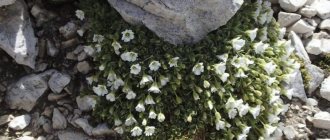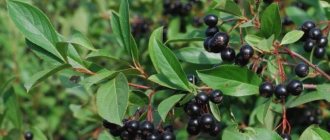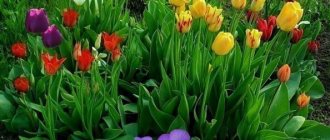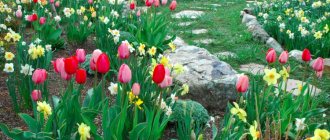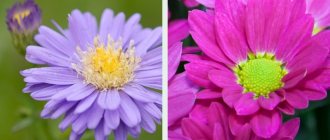Rules for creating a border of flowers
When creating a flower border next to a path, you should adhere to a number of principles. First of all, this applies to the choice of plants. For example, by planting without taking into account growth, after a while you may end up with an impassable path overgrown with greenery.
Flower garden path fencing Source zen.yandex.ru
To avoid these and other troubles, use these tips:
- Contrast of plants used for edging purposes with flower garden plantings.
- Plant low-growing perennial plants with reserve for subsequent growth.
- You can avoid unsightly gaps in the path hedge by planting 2 rows of plants.
- Give preference to slow-growing plants. This will reduce the likelihood of overgrown lashes falling apart in different directions and will make the frame look neat and tidy.
Advice! Stick to the classic sizes of living flower borders: no more than 500 mm. in width, and 400 mm. in height. However, these conditions can be violated based on the location of application and garden design.
Smooth herniator
It is difficult to imagine a plant that would be better suited for planting between path slabs than hernia grass. One single bush of this crop will easily fill a space within a radius of 60 cm around itself. Hernia flowers are so small that its flowering period can pass unnoticed even by the owner of the site. An additional advantage of this plant is its “slowness”. Typically, ground covers spread throughout the area so quickly and unceremoniously that after some time the owner of the territory may begin to regret that he once rejoiced at the unpretentiousness and vitality of the new pet. While the herniator does this moderately leisurely, giving the owner time to come to his senses and begin defense in a timely manner.
- Carefully! Ornamental plants that can quickly become weeds
Not all ornamental crops are equally safe for your garden. How to recognize and stop an aggressor plant?
What to plant along the path in the country
Low-growing plants as a frame for a winding sidewalk Source zen.yandex.ru
The choice of plants for a flower garden along the path is done with an eye on the characteristics of the area being landscaped. It is most rational to use decorative seedlings that are suitable for different areas, regardless of the size and layout of the territory. At the first stage, a planting plan is drawn up taking into account the following factors:
- The purpose of plantings: protection, beauty or shading of the local area.
- Distance to external fence. Its shape, the material from which it is made, airflow. In the future, plants should not interfere with the approach in case of repair or painting.
Advice! When creating a flower garden along the path, give preference to plants of different types that differ in flowering periods. Such combinations are called mixborders.
See also: Catalog of companies that specialize in landscaping work on sites.
Preparatory activities
The easiest way to decorate a small garden with vegetable beds is to plant flowers of different types along the paths, complementing all this with small flower beds and flower beds. But even in this case, the paths must be planned and landscaped before planting. Any material for decorating paths is suitable, as long as it matches your ideas of beauty.
Can be used:
- fine gravel or large flat stones;
- paving slabs or composite boards;
- pallets or decking.
The directions can be made flexible and winding, or you can give them clear geometric shapes.
When starting to decorate the path, consider:
- the flowers will grow on the sunny side or in the shade;
- will they be simply decoration or will they have a protective function;
- how high the flowers will rise in growth;
- whether they will require constant care.
Having decided these issues for yourself, you can begin disembarking.
List of low-growing plants
Colorful landscape of a garden plot with differences in elevation Source www.rutvet.ru
An impressive list of low-growing flowers, thanks to which a beautiful flower bed is organized along the garden path, is conventionally divided into several categories:
- Ground cover.
- Herbaceous.
- Conifers.
- Beautifully blooming.
They can also be perennial or annual, that is, the latter will have to be renewed every spring.
Garden path in combination with plants of different varieties Source www.tsvetnik.info
As an example of the correct organization of a flower bed along a path, let’s consider several different varieties, the use of which will advantageously embellish any flower bed:
- Sedum (sedum) – grows no more than 15 cm in height. Able to withstand serious influences: drought, abundance of moisture, human attack. There are different varieties, differing in size and color of the leaves.
- Scottish moss - does not “rise” above 3 cm. Prefers warm, shaded areas, average watering. It is preferable to plant on the eastern side of the site, where the plant will receive protection from ultraviolet radiation.
- Juniper horizontalis is a slow-growing plant of the coniferous groundcover family. Does not rise above the ground above 4-5 m. The color of the needles in the warm season is silver-blue, in winter - with a purple tint.
- Wild, elfin, and Breckland thyme (creeping) blooms in late May - early June. The shoots, crowned with light purple flowers, do not stretch upward, but spread along the ground, emitting a sweet fragrance.
- Garden chamomile is an unpretentious plant with healing properties. Prefers a cool, dry environment and grows in any type of soil.
- Viola creeping (Loosestrife) – the purple small flowers of the plant harmonize perfectly with paving stones and steps. Creates a strong green frame in early spring, maintaining it until late autumn. Planting this plant as a frame for a flower bed attracts a large number of butterflies.
- Veronica creeping - blooms with blue or white flowers 2-3 times during the summer season. Prefers plenty of sun, but does not die in shaded areas.
Bloodroot
The charming cinquefoil is ideal for garden design.
The plant blooms throughout the warm season. It is unpretentious and survives even on infertile soil. There are several types of cinquefoil, which can be a ground cover plant or a shrub. The shades of the leaves and their size also depend on the variety. The flowers are white and light orange. They have a tender and fluffy center, golden due to the many stamens.
Cinquefoil is usually not affected by pests. It is ideal for an alpine slide or rock garden. Sunlight will benefit this plant. And being surrounded by stones will make its appearance even more exotic.
Tall flowers
A winding path bordered by rich greenery Source www.botanichka.ru
For floral edging of the border of a garden path, plants with a height not exceeding 40-50 cm are used. As an example, consider options for using annual representatives of this group:
- Ageratum Houston (Mexican) is a heat-loving variety, planted after the threat of night frosts has passed. The plant blooms in lush baskets of small flowers in pink, blue, and purple shades. Creates a lush surface, the height of which is adjusted by pruning the shoots. Recovers in a few days. It blooms in early June and remains in this fragrant state until the first frost.
- Salvia (sage) - the flower reaches a height of up to 50 cm. For border frames, low-growing varieties are used: “Fireball”, “Vesuvius”. It is grown only through seedlings. The bright red flowers of the plant harmonize perfectly with the miniature yellow leaves of marigolds or silvery ciniririums.
Beautiful perennials Source flo.discus-club.ru
- Hybrid nasturtium - the plant will decorate the landscape design of the garden not only with voluminous, rich flowers of light yellow or fiery red, but also with original leaves. Large, rounded, suspended cuttings look impressive. To decorate the border of a flower bed, bush varieties are used: “Strawberries with Cream” and “Jewel Mix”; species with unusual variegated leaves are also used: “Alaska Golden”, “Alaska Scarlett”.
- Coreopsis - yellow, orange or golden flowers on a thin stalk can be planted in open ground. For this purpose, the Crimson King variety is used, reaching a height of 30 cm.
Euonymus
In the natural environment, the crop can grow up to 10 m. Low-growing forms of the plant are cultivated in summer cottages. A guest from the subtropics has long taken root in the gardens of the middle zone and even received many popular names.
For planting, you can choose a creeping shrub or a low tree. Euonymus shoots usually have very interesting-looking cork growths in the form of ridges or longitudinal ribs.
The leaves have a beautiful smooth surface; they can be uniform in color or completely variegated. At the end of the warm season, the foliage turns purple, bronze or gold and adds a distinctive touch to the surrounding landscape. Euonymus seed pods are very decorative; they are burgundy, pink or purple. Despite this, the fruits should not be tasted. They are poisonous.
Perennials
A bench on a garden path framed by greenery Source www.botanichka.ru
The main advantage of perennial plants in their use to create a flower garden along the path is practicality. They do not have to be planted at the beginning of each season, trembling before the start of the growing season, and preparing seeds for the next year in the fall.
- Sedum Vidny - during the flowering period reaches a height of 40 cm. It grows in abundant shoots on a thick stalk. The top is crowned with pink flowers that do not fade from the beginning of August to the end of September. It is unpretentious to soil and watering. It grows both in the shade and in well-lit areas.
- Heuchera small-flowered - the plant is used in border framing and filling high edgings. An evergreen perennial with large green or dark purple leaves extending no higher than 15-20 cm above the soil. The flower joints rise on a long, rigid stalk, holding small cream or pink flowers.
- Narcissus - used for early decoration. The bulbous plant blooms in mid-April, retaining its petals until the May holidays. It is found with snow-white or yellow petals with a golden stamen. It is unpretentious to soil and grows well both in the shade and in the sun. However, in warmer areas, where the snow melts first, it rises faster.
Asphalt path with flower beds instead of borders Source flo.discus-club.ru
- Lavender - fluffy, fragrant bushes are popular among herbalists who prefer natural tea. Bright purple spikelets in the border of a garden path look impressive, but require regular care. Growing will require periodic loosening of the soil, regular watering, fertilization, and preparation for winter. The plant also prefers sunny, draft-free places and vapor-permeable soils saturated with an alkaline reaction.
- Cinquefoil (shrub cinquefoil) - the plant is used to create a flower border in white, yellow or red. It does not exceed 1 m in height. It blooms at the end of May, retaining the inflorescences until the first frost. It tolerates frosts in central Russia well and is not susceptible to pests, drought, or soil conditions. Care is required only in spring: dry, weak shoots are pruned in March-April.
- Mussolini's catnip is an ideal option for rocky, infertile soil. It blooms on any side, but the maximum effect of the inflorescences is achieved where they are heated by the sun's rays. It does not exceed 40 cm in height, has an original blue-lilac hue, and blooms throughout the summer season.
Original landscape design Source happymodern.ru
Important! A significant disadvantage of perennial plants in flower beds along paths is their short flowering period compared to annuals.
Chaenomeles
Japanese quince, or chaenomeles, blooms in early spring. Its orange-yellow, dark red, white or pink petals create an atmosphere of awakening nature in the garden. The bush itself is quite low, sometimes its branches spread along the ground.
Chaenomeles are most often placed in borders. The plant will not create problems for the gardener - it grows quite slowly in size.
Chaenomeles fruits are considered a natural pharmacy due to the large amount of trace elements and vitamins. From a bush you can get up to 6 kg of fruit like an apple. They usually have a golden skin and orange-tinged flesh. The fruits have a subtle lemon aroma, exquisite taste and remain on the branches for more than a month. Japanese quince begins to bear fruit 4 years after planting.
What flowers to plant along the paths so that they bloom all summer
Saturation of flowers and greenery Source fishing-caravan.ru
A competent choice of plants will allow you to create a flowerbed border that blooms throughout the summer. To do this, there is no need to devote a lot of time to floriculture. It is enough to use seedlings that can please the eye for several months:
- Dimarphotheca (Cape marigold) is an unpretentious annual plant with flowers of various colors: yellow, apricot, orange, pink, lilac, blue. It blooms in the first half of June, retaining tender buds until the end of August. It reaches a height of 60 cm.
- Cosmea - plant flowers are found in almost all city flower beds. A unique plant that can grow in any conditions: absolute drought and lack of watering, full shade, open sun, on any type of soil. Propagates by self-sowing.
- Eschscholzia califirnia - blooms in the first half of June, fades in early October. Bright red, rich flowers are obtained when planted in well-lit areas; it prefers sandy soils and does not require additional feeding. Propagates by self-sowing.
- Antirrinum (Snapdragon) - has bright flowers of unusual shape with a rich palette of different shades. The color of the plant can be pink, yellow, red, beige, blue, cyan, two or three colors. Branched shoots, rising no more than 60 cm, are united into pyramidal bushes. They are crowned with numerous inflorescences distributed throughout the height. It does not tolerate winter well, so it is often used as an annual.
Framing the garden path with low-growing shrubs Source classpic.ru
Rustic garden path
A walk along the winding path made of wild stone, going deep into the garden, will be much more pleasant, accompanied by the colorful herbs and aromas of bright summer flowers with an unpretentious disposition. By the way, if you do not have the opportunity to lay the path with stones, you can imitate them using a special form. How to do this is written in this article.
In the gaps between the stone slabs, plant ground cover Sedum cultivar “Yellow Queen”, which, growing quickly, will fill the voids with a dense turf of emerald-yellow foliage. By the beginning of July, the terry rug between the stones will be decorated with golden lights from numerous small flowers.
On both sides of the path, plant flowers of Lobelia brillianti, Echinacea purpurea, Galtonia whitish, Rudbeckia brillianti and Salvia officinalis in small dense groups, alternating them with textured ornamental foliage plants - Morrow's sedge and Gray's ragwort. To add texture to the composition, use side plants in tubs, for example, New Zealand flax, the rigid plumage of which will create a bright contrast with the light Lavender angustifolia, low-growing Erica meat-red and delicate Asian hybrids of Lilies in the background.
Other equally attractive aromatic plants are also suitable for decorating garden paths in a rustic style:
Tall plants:
Delphinium tall, Przhevalsky's buzulnik, Katran cordifolia, Astilbe Arends
Tall grains:
Acute-flowered reed grass, Chinese Miscanthus, greater fescue, reed molinia
Low growing plants:
Sedum flowering, Carpathian bellflower, Dalmatian geranium, Anaphyllis three-veined
Decorative foliage:
Spotted lily, Colchis evergreen Horny goat weed, Wavy hosta, Paniculata fescue
Ornamental shrubs for Siberia
Ornamental shrubs that are suitable for Siberia:
Elderberry Black Beauty is an example of a perennial garden shrub for areas where there are severe winters and recurrent frosts.
- The white dogwood or dogwood of the dogwood family is distinguished by its branching and grows up to 3 meters. Leaves with edges, dark green, dense;
- elderberry is valued for its carved leaves that change color in late autumn and clusters of fruit. Breeders have developed varieties with colored greens;
- spirea in species diversity: pyramid-shaped; in the form of hemispheres; liana-like with spreading long shoots that can rest on support;
- cold-resistant types of barberry: thunberg varieties; Amur; common fruiting; Ottawa.
- Potentilla or Kuril tea is winter-hardy, blooms profusely, the color of the buds is yellow or white.
Important! Young ornamental bushes under the age of 3 years are bent down for the winter so that the branches are under the snow cover. In the spring, sanitary pruning is done on adult bushes and the frozen part of the shoots is removed.
How to arrange a monoflower bed
Not far from the paths you can organize a monoflower bed.
Spring-flowering
People who want to decorate their garden in the spring can plant spring-blooming flowers in the area. These plants include the following:
- double varieties of daffodils;
- forest type forget-me-not;
- lilac bushes;
- periwinkle.
Summer flowering
Most flowers bloom in summer, and therefore many gardeners make a monoflower garden from summer-blooming seedlings. Popular flowers that bloom during the summer include:
- delphinium;
- aconite;
- tobacco;
- hibius.
Autumn-flowering
To decorate your garden and path in the fall, you need to plant fall-flowering plants. Among the flowers that bloom in autumn are:
- buddleia;
- aster;
- clematis.
Decorative foliage
To decorate the garden area, some gardeners recommend planting decorative foliage plants. They have foliage of various shapes. Moreover, it can be painted not only green, but also other colors.
Ground cover shrubs
In creeping crops, the roots do not go deep, spread under the surface, and sprout new shoots. A feature of ground cover shrubs is their ability to quickly fill free space. When choosing beautiful unpretentious shrubs, consider:
- demands on soil. The intensity of plant growth depends on the correctly chosen planting site;
- frost resistance. It is not customary to cover borders and areas with stones covered with ground cover crops;
- resistance to diseases and pests;
- flowering time.
Note ! When selecting neighboring plants, take into account the height of the cover being formed.
Ground cover shrubs are coniferous, herbaceous, liana-like, producing shoots up to 5 meters long. Perennials displace weeds from the occupied area and strive to take over new territories. In addition to the aesthetic function, they have a practical function, ridding the soil of contamination. Conifers are compact and grow slowly. Herbaceous ones have good growth and delight with flowers.
For sunny places, all types of fescue are suitable from cereals; from flowering sun-loving perennials, choose:
- alyssum;
- peg;
- blue carnation with an original shade of green;
- catnip, better known as catnip;
- dwarf phlox;
- ground cover asters.
The white cap of Iberis is formed during flowering, the rest of the time the evergreen snowflake pleases with beautiful foliage
Shade-tolerant plants are planted in shaded areas:
- blue periwinkle;
- cuff with decorative leaves in the form of umbrellas;
- creeping tenacious with plumes of inflorescences;
- hostas with colored greens;
- brunner macrofolia;
- white clover, it weaves everything in its path.
Landscape design can turn any area of the garden into a fabulous, unique landscape
There are no specific canons in landscape design; owners of countryside vacation spots decorate the area to their liking. Crops selected for climatic conditions require minimal care. They need to be shaped and periodically fed, then the area will turn into a piece of paradise.
Flowering shrubs for the Urals
They are distinguished by their special variegation and abundant flowering:
- perennial shrub aster;
- varieties of Argyrantemum fruticosa or “Alpine daisies”;
- chrysanthemums or evening primroses from the fireweed family.
In the Ural conditions, most of the perennial shrubs that bloom in summer survive and are used in landscape design for summer cottages and parks. Many spend the winter without shelter.
An example of a mixborder of shrubs and perennials
Where to begin?
Experts advise planning and placing trees and shrubs along the fence and paths immediately, simultaneously with planning a suburban building. An integrated approach to organizing and filling space will allow the summer cottage site to acquire a lived-in appearance by the end of construction work, be filled with greenery and look like a real kingdom of nature.
Site plan with location of shrubs
Before starting landscaping work, inspect the area, familiarize yourself with its advantages and pay attention to its disadvantages, evaluate the possibilities and conditions for planting. This is very important for choosing varieties and varieties of trees and shrubs.
When arranging a suburban area, in order to maintain the harmony of all components and get a complete space, it is better to pay attention and be guided by the recommendations developed by specialists. Before deciding which plantings will grow near the fence, which bushes inside the territory, you need to pay attention to the suburban space and get answers to the following questions:
1. Decide on the purpose of the bushes and trees used for landscaping the site. Figure out what your goal is when planting: to close an ugly fence or to decorate a lovely structure. Choose what main function the plants will serve: to camouflage the fence or to harmoniously coexist with it.
Masking a fence with bushes
2. Determine for yourself what part of the space falls under the control of trees and shrubs, and how much free space it costs to leave. Do not overload the area. Excessive loading of trees and shrubs along the fence, especially tall plants, will visually reduce the area and make it oversaturated.
Shrubs along the paths should not overload the space
3. Determine which side of the fence is available for planting: brightly lit by the sun or constantly in the shade. When planting trees, focus on the shade cast by the fence and plant plants that grow well in those shady conditions.
Barberry bushes tolerate shade well
4. What is the soil like in the area of future planting? In order for a plant to truly reveal its decorative properties, it must grow in comfortable conditions.
5. How much subsequent care is expected for the plant. Is it possible to provide constant attention to the capricious flora, to provide pruning and shaping of trees and shrubs that need it?
Hedges need regular maintenance
There are two options for the formation of vegetation on a personal plot:
1. Landscape planning does not require special human participation. This method of forming a territory is especially suitable for areas located on uneven terrain. In this case, due to the natural difference in levels, the plants look beautiful and together form interesting compositions.
Free landscape planning of the site
2. Geometric layout involves maintaining certain distances between bushes and trees and maintaining strict geometric shapes. Most often, in this case, rows of densely planted trees are created. There is empty space between the rows and lonely vertical plants in the middle of the plot.
Strict geometric layout of the site

